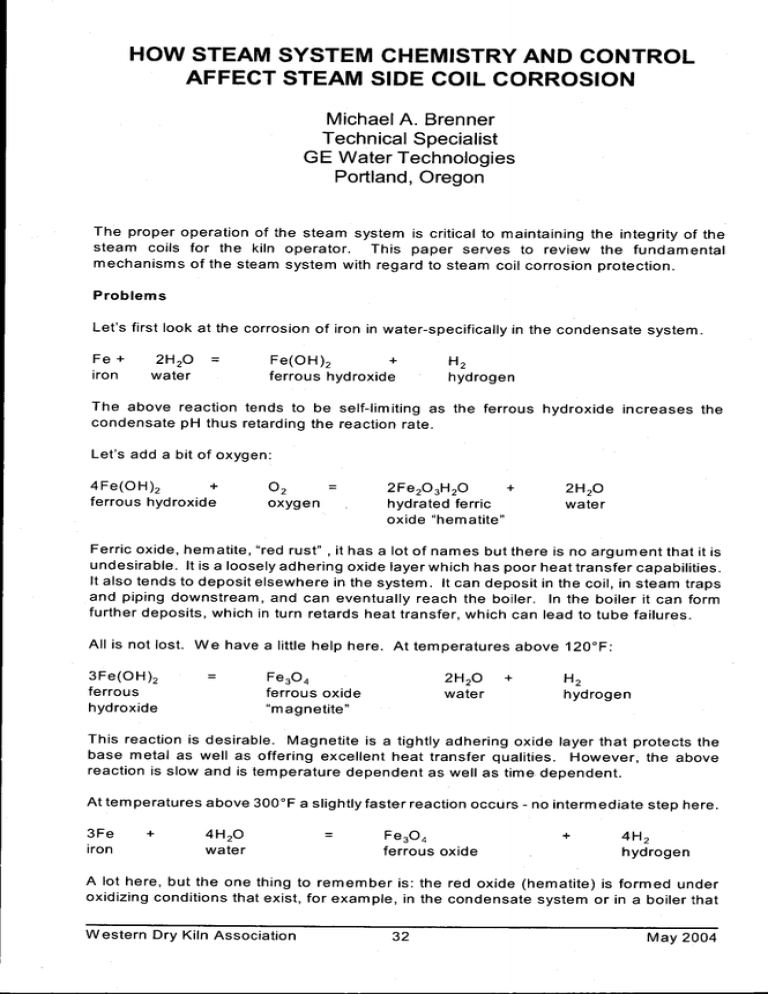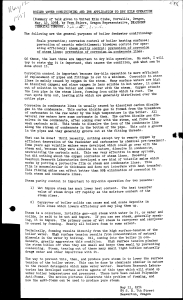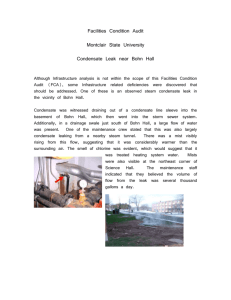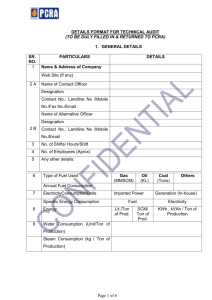HOW STEAM SYSTEM CHEMISTRY AND CONTROL AFFECT STEAM SIDE COIL CORROSION
advertisement

HOW STEAM SYSTEM CHEMISTRY AND CONTROL AFFECT STEAM SIDE COIL CORROSION Michael A. Brenner Technical Specialist GE Water Technologies Portland, Oregon The proper operation of the steam system is critical to maintaining the integrity of the steam coils for the kiln operator. This paper serves to review the fundamental mechanisms of the steam system with regard to steam coil corrosion protection. Problems Let's first look at the corrosion of iron in water-specifically in the condensate system. Fe + iron 2H20 = water Fe(OH)2 ferrous hydroxide H2 hydrogen The above reaction tends to be self-limiting as the ferrous hydroxide increases the condensate pH thus retarding the reaction rate. Let's add a bit of oxygen: 4Fe(OH) 2+ ferrous hydroxide 02 = oxygen 2Fe2O3H2O + hydrated ferric oxide "hematite" 2H20 water Ferric oxide, hematite, "red rust" , it has a lot of names but there is no argument that it is undesirable. It is a loosely adhering oxide layer which has poor heat transfer capabilities. It also tends to deposit elsewhere in the system. It can deposit in the coil, in steam traps and piping downstream, and can eventually reach the boiler. In the boiler it can form further deposits, which in turn retards heat transfer, which can lead to tube failures. All is not lost. We have a little help here. At temperatures above 120°F: 3Fe(OH)2Fe304 ferrous ferrous oxide hydroxide "magnetite" 2H20 + water H2 hydrogen This reaction is desirable. Magnetite is a tightly adhering oxide layer that protects the base metal as well as offering excellent heat transfer qualities. However, the above reaction is slow and is temperature dependent as well as time dependent. At temperatures above 300°F a slightly faster reaction occurs - no intermediate step here. 3Fe iron 4H20 water Fe304 ferrous oxide 4H2 hydrogen A lot here, but the one thing to remember is: the red oxide (hematite) is formed under oxidizing conditions that exist, for example, in the condensate system or in a boiler that Western Dry Kiln Association 32 May 2004 is out of service. The black oxide (magnetite) is formed under reducing conditions that typically exist in an operating boiler. Hematite has been called "bad rust" and magnetite has been called "good rust." Let's switch gears a bit. We noted that oxygen plays a large part in the corrosion process. So, how did it get into the system? Oxygen, as well as carbon dioxide, are both present as dissolved gasses from boiler makeup supply. However, the primary source of carbon dioxide is from specific minerals in the boiler water. Carbonates (CO 3-2) and bicarbonates (HCO31 ) are commonly present in the makeup water (combined we call these anions "alkalinity") and in the boiler undergo the following reactions: 2NaHCO 3 + heat = sodium bicarbonate Na2CO 3+ sodium carbonate Na22CO3 sodium carbonate H2O = water + 2NaOH sodium hydroxide CO2 + carbon dioxide + H20 water CO2 carbon dioxide Both the oxygen and carbon dioxide are considered "non-condensable gasses." Due to their poor solubility in hot water, they leave the boiler and travel with the steam and as the steam condenses they undergo the following reaction: H 2O water + CO2 carbon dioxide H2CO3 carbonic acid In simple terms, carbon dioxide is formed which then forms carbonic acid. Carbonic acid depresses the condensate pH which increases the general corrosion of ferrous metals. We aren't done yet. As steam is condensed in the condensate system, the following reactions occur. H 2CO 31-1+ carbonic acid hydrogen ion HCO3 bicarbonate ion HCO 3H+ bicarbonate ion hydrogen ion CO3 -2 carbonate ion 2H +HCO3 hydrogen ion bicarbonate ion Fe iron = Fe(HCO3)2 ferrous bicarbonate + H2 hydrogen This reaction is also self-limiting as the ferrous bicarbonate increases the condensate pH thus retarding the reaction rate. Please note that for those with "hard" boiler makeup water (water high in calcium and magnesium), the above mechanisms stand out even more as you most likely have higher concentrations of carbonates and bicarbonates. Finally, oxygen and carbon dioxide can be drawn into the coils through leaks. The most common occurrence is when the steam supply valve is shut to the coil and the residual steam condenses. This will cause a slight vacuum in the system drawn in outside air and organics (typically acidic in nature). Western Dry Kiln Association 33 May 2004 Prevention The first line of defense is mechanical deaeration. Typically, condensate and makeup water combine in a "makeup tank" prior to being introduced into the boiler. The amount of makeup water and the temperature of this tank as well as residence time are key factors in how well this tank deaerates (or removes noncondensable gasses). Last, but not least, it is important to sufficiently vent the "makeup tank" to remove any noncondensable gases that may have formed. The second line of defense is chemical oxygen scavenging and chemical condensate control. Let's look at oxygen scavenging first. Basically, that is the addition of a chemical to react with the oxygen leftover from mechanical deaeration. This chemical is usually fed below the waterline of a "makeup tank" or to the storage section of a deaerator. The most common oxygen scavenger is catalyzed sodium sulfite. The reaction mechanism is: 2NaSO 302 sodium sulfite oxygen 2NaSO4 sodium sulfate Another oxygen scavenger is diethylhydroxylamine (also known as DEHA). The reaction mechanism is a complex process involving several reactions. The overall reaction can be summarized as: 4(C 2H 5)2NOH + DEHA 902 oxygen 8CH3COOH acetic acid 2N2 + 6H20 nitrogen water When sodium hydroxide is present in the boiler water, the acetic acid is neutralized and removed by blowdown as sodium acetate. DEHA has an additionally benefit which will be explained later. Let's now look at chemical condensate control. Ultimately, the goal is to reduce corrosion of the condensate system. There are a couple of schools of thought here. First and foremost, we must elevate the pH of the condensate system to offset the introduction of carbonic acid (which is trying to reduce it). Neutralizing amines are a group of chemicals that flash to a vapor and travel with the steam. Ideally, they are fed to the steam header but can be fed to the "makeup tank" if needed. There are many types of amines and their reaction equations are beyond the scope of this paper, however, a few items need to be mentioned. First, more than one neutralizing amine may need to be fed based on their neutralizing capability and distribution ratio characteristics. Neutralizing capability is the concentration of acidic contaminants that is neutralized by a given concentration of amine. Distribution ratio is simply the ratio of amine in the vapor phase as compared to the ratio of amine in the liquid phase. For protection of steam coils in dry kilns, typically more than one amine is used. Another school of thought is the use of filming amines in the condensate system. Filming amines are typically fed into the steam header and its purpose is to form a molecular layer on the inside of steam/condensate piping and components. If fed properly, this barrier layer prevents oxygen and carbonic acid from reacting with the base metal. The success of this barrier level is based on proper pH control and can result in excessive removal of preexisting deposits which then form large amounts of sludge which can then foul components in the condensate return system. In gross cases, these sludges have reached the boiler resulting in catastrophic tube failure. Another school of thought is the use of DEHA as a metal passivator as well as an oxygen scavenger. DEHA promotes the conversion of unprotective iron oxide (red hematite) to Western Dry Kiln Association 34 May 2004 a protective film (black magnetite) on system metal surfaces. The reaction mechanism is as follows: 2(C 2H 5 )NOH DEHA + 6Fe2O3 = ferric oxide hematite 4Fe3O4+ ferrous oxide (magnetite) 4CH3COOH acetic acid + 3H20 water DEHA renders metal surfaces less active, reducing overall corrosion rats. Therefore, corrosion product loading to boiler feedwater is reduced. DEHA is usually employed in conjunction with a neutralizing amine program, as it is most effective above a pH of 8.0 DEHA also has a very high distribution ratio of and therefore will distribute more effectively throughout a complex steam and condensate system. Due to DEHAs high distribution ratio, effective condensate protection can often be achieved from its application to the boiler feedwater versus the more traditional steam header. Back to Operations. How the kiln operator cycles the boiler is also important. For the most part, the kiln operator controls boiler cycles of concentration (also known by its abbreviation "cycles") by boiler water conductivity. Cycles too high, another topic, as we can be causing carryover as well as causing retrograde soluble salts to come out of solution (also known as "scaling"). Cycles too low: for a given steam rate that means your makeup rate is higher than normal, which in turn introduces additional oxygen and carbonates and bicarbonates. More issues downstream in the steam/condensate system. Also, your water bill is higher and fuel bill is higher as you are sending perfectly good (heated/treated) water down the drain. If the kiln operator has a "choice" pick a boiler water makeup source that is low in alkalinity. The lower the alkalinity, the less chemical addition may be needed to lessen the corrosion rate in the condensate system. Please note that water softener will exchange calcium and magnesium ions with sodium but will not affect boiler alkalinity. Dealkalizers and to a degree Reverse Osmosis units can reduce the alkalinity of the water which in turn can reduce the carbonic acid formation in the condensate system. Proper operation of steam traps can prevent condensate from backing up in the coil. If the steam trap is not operating properly, condensate can collect in the coil and begin to cool. The condensate can actually drop below the temperature at which it condensed. This is known as subcooling. As the temperature drops, the condensate can more readily absorb oxygen and carbon dioxide which will result in a localized corrosive environment. The kiln operator can actually be doomed with a system in which the condensate collection tank is above ground. At low steam flows, condensate will back up into the coil due to the lack of pressure. Subcooling occurs, localized corrosion can occur. Next, it goes without saying, "fix your leaks." First, repairing leaks helps reduce steam/condensate losses which reduces the amount of makeup water needed. Also, repairs will help minimize the intrusion of oxygen and carbon dioxide as well as organics whenever a vacuum is formed. Looking at the bigger picture, fixing leaks will allow the kiln operator to control the drying process more accurately. In summary, the corrosion of steam side coils can be prevented via mechanical, operational, and chemical means. Knowledge is important. Please confer with your counterparts or ask for assistance from experienced consultants if you have any questions. Western Dry Kiln Association 35 May 2004


